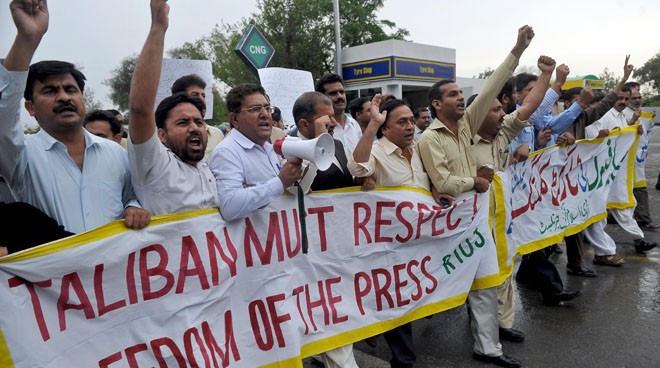

As we observe yet another International Press Freedom Day on May 3, we realise that the very concept -- press freedom -- has become a myth in the Pakistani context. And this despite the presence of about a 100 private television channels, dozens of FM radio stations and hundreds of newspapers. But are they all free and independent is a key question.
It has become next to impossible to exercise your editorial judgment while reporting on terrorism, sectarian and ethnic conflict, financial scams, and issues related to national security. It’s not just the government; even the pressure groups and militants now dictate where the news must be placed, in how many columns, with suggested headlines and editing guidelines.
Pakistani media is not as free as it was some years back when strong editors took strong positions. Now, the pressures are life-threatening but there are very few editors left who resist. Media is now reporting under pressure and not with free will or as per "editorial judgment".
Today, one may not even find independent tv reviews; each media group covers reviews of its own channel which are inevitably all in praise of the programme content.
Talking of violence, in the last 16 months alone 15 journalists have been killed, making things worse for freedom of the press. Free and fair reporting remain a dream. Reporters, anchors, producers, cameramen all face threats. The new trend of attacks on offices has further increased the pressure on the newsroom.
Therefore, there is a price to pay and a heavy one for speaking the truth. The question is: are we all ready to defend the people’s right to know and that too at this cost?
For the first time in media’s history, owners, editors and director news are all under threat. Only from March 1 to April 5 this year, over 15 incident of violence against journalists occurred and six journalists received death threats. If last year eight journalists were killed, the figure has already touched six in the last three months alone.
Following the killing of three workers of Express channel in Karachi, one of its senior anchors Raza Rumi survived an armed attack in Lahore but his driver was killed. He is left with no other option but to quit his job. Another senior journalist Imtiaz Alam has claimed receiving death threats. There were four direct attacks on the channel while explosives were recovered from outside the office and residence of its Peshawar bureau chief.
GEO’s senior editorial staff members and a couple of other channels have faced threats. Following a senior anchor Hamid Mir’s incident, Editor Investigations of The News Ansaar Abbasi and his colleague Ahmad Noorani have also received threats. Shan Daer, Larkana correspondent of another private channel, was killed on the New Year’s eve. One can keep counting such incidents -- from threatening calls to hand grenade attacks on different media outlets.
As for suppression of the state, several anti-media laws still exist and have been used at times to suppress the news. For instance, registration of cases under Anti Terrorism Act against nine newspapers in Balochistan and trial of a journalist from FATA under anti-terrorism charges has raised question mark about the amount of press freedom that exists in Pakistan.
In the last 15 to 16 months, things have been getting more and more difficult for the private media to report freely. As a result some of the owners have left Pakistan and are operating from abroad. They are finding it extremely difficult to continue if the situation persists. The situation has made this industry whose worth is about Rs50 to 60 billion a year quite vulnerable and the future of about 25,000 to 30,000 employees is equally uncertain.
In many cases, threats have even forced journalists to move from one city to another, change their locations within the city, avoid live shows and change topics. Four of them have already got security guards.
Pakistani journalists have come a long way to achieve their freedom. They have faced all kinds of pressures from successive regimes, military as well as civilian, but never before is there such a wave of panic and concern.
On average 10 journalists are being killed in Pakistan every year and at least 10 to 15 have had to shift their homes from one city to the other against their own will due to threats. Freedom of expression is non-existent in Balochistan where the media faces the worst situation; in many cases the journalists, particularly those sitting in the newsroom, are not even free to place the news items as per the judgment of the city editor or news editor. Judicial restraint from the Balochistan High Court about a year back against publishing any statement or press release of outlawed groups has further complicated the situation for local journalists.
By and large, journalists have neither security nor any safety training; they neither have good salary nor life insurance. Therefore, they either take sides or report under huge mental stress.
In recent years, journalists and media houses have also been accused of encouraging immoral and unethical practices to earn money. Some of the shows came under heavy criticism and, in a few cases, evidences were also provided about the ‘fixed shows’.
Those who attack the media, kill journalists or media workers, are actually killing the very concept of free media and free expression in the country. So everyone in the media and in the civil society should try to rescue this industry from complete collapse.